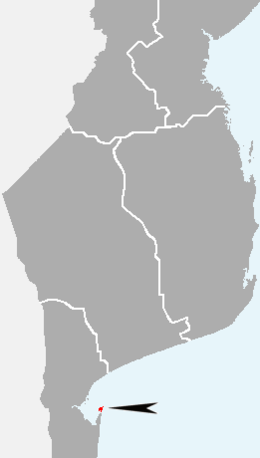Inhaca Island
Native name: Ilha da Inhaca | |
|---|---|
 Viewed by Sentinel-2 of the Copernicus Programme | |
 Location in southern Mozambique | |
| Geography | |
| Location | Indian Ocean |
| Adjacent to | Maputo Bay |
| Area | 52 km2 (20 sq mi) |
| Length | 12 km (7.5 mi) |
| Width | 7 km (4.3 mi) |
| Highest elevation | 104 m (341 ft) |
| Highest point | Mount Inhaca |
| Administration | |
Mozambique | |
| Municipality | Maputo |
Inhaca Island (Portuguese: Ilha da Inhaca), also known as Kanyaka island, is a subtropical island of Mozambique off the East African coast. The main village is Inhaca, situated just over a kilometer from Inhaca Airport. Various tourist lodges are situated along the northwestern coastline. The island is flanked by protected areas along the western and eastern coastlines, while the majority of the population lives in the interior.
The 52 km2 (20 sq mi) island separates Maputo Bay (Baía de Maputo) to the west from the Indian Ocean off its eastern shores. The island's irregular coastline approaches the mainland Machangulo peninsula at Ponta Torres where a 500-metre-wide (1,600 ft) tidal race separates the two headlands. In administrative terms Inhaca is a municipal district of the municipality of Maputo, while the Machangulo peninsula is included under the Lubombo Transfrontier Conservation Area and is part of the district of Matutuíne, Maputo Province.
Geographical features
The island's dimensions are approximately 12 km (n-s) by 7 km (e-w). The highest point above sea level is the 104-metre (341 ft) Mount Inhaca on the north-eastern shoreline. The south-western peninsula is known as Ponta Punduine while Ponta Torres to the south-east approaches the mainland. Two inland swamps occur at the northerly airstrip and southern Nhaquene respectively. Besides Inhaca settlement on the western shore there are five smaller villages including Inguane, Nhaquene, Ridjeni and Tobia.
History
Despite being a part of the Portuguese Mozambique until 1975, the island of Inhaca, so close to the harbour of Maputo, was occupied by the British from 1823 until the MacMahon Treaty of 24 July 1875. The British used the island (amongst many others all around Africa) to patrol and control the slave traffic in the region.[1]
Ecology
Flora

The island is a regular destination for ecotourists and ecological researchers. The central land area consists of cultivated fields, while grassy plains are found to the north, flanked by protected usnea-covered dune forests along the eastern and western shores. Extensive exposed mudflats fringe the western and southern shores at low tide. Mangroves cover large sections of the northern shores and southern Saco Bay.
The sub-tropical evergreen forest on the island includes the following tree species:
Fauna
Among 160 coral species are staghorn and plate corals. There are two badly damaged pure coral reefs flanking the island's western perimeters, in very shallow water, which are supposed to be protected but in reality there is no actual control of the marine reserves.
Conspicuous fish are
Cetaceans
Although
Resident populations of the
Other mammals and reptiles
A very small, remaining population of
Birds
Inhaca is home to about 300 bird species, both resident and
Demographics
The island has a population of around 6,000.[7]
Economics
The island has traditionally had a large fishing sector, although fish stocks have decreased in modern times. There are attempts to develop a sustainable Perna mussel aquaculture practice. Tourism also contributes to the economy.[7]
Gazetteer of landmarks and villages
- Inhaca 26°00′17″S 32°54′52″E / 26.00472°S 32.91444°E
- Inhaca Airport 25°59′52″S 32°55′45″E / 25.99778°S 32.92917°E
- Inhaca lighthouse 25°58′36″S 32°59′18″E / 25.97667°S 32.98833°E
- Inguane 26°00′07″S 32°57′23″E / 26.00194°S 32.95639°E
- Marine biological station 26°02′17″S 32°54′12″E / 26.03806°S 32.90333°E
- Mount Botelho 26°02′14″S 32°57′47″E / 26.03722°S 32.96306°E
- Mount Inhaca 25°59′48″S 32°58′39″E / 25.99667°S 32.97750°E
- Nhaquene 26°02′57″S 32°54′30″E / 26.04917°S 32.90833°E
- Ponta Ponduine 26°04′13″S 32°54′17″E / 26.07028°S 32.90472°E
- Ponta Torres 26°04′47″S 32°57′18″E / 26.07972°S 32.95500°E
- Ridjeni 26°00′12″S 32°55′09″E / 26.00333°S 32.91917°E
References
- A natural history of Inhaca Island, Mozambique by William Macnae, Margaret Kalk and J. de Koning, 1995
- Birds of Inhaca Island, Mozambique by de Boer, W. F. and Bento, C. M., 76pp, 1999.
- ^ Para a História da Aliança Luso Britânica, by José be Almada, Imprensa Nacional de Lisboa, 1955, pp. 60-61
- ^ Banks A., Best P., Gullan A., Guissamulo A., Cockcroft V., Findlay K. (2010). "Recent Sightings of Southern Right Whales in Mozambique" (PDF). Retrieved 18 December 2014.
{{cite journal}}: Cite journal requires|journal=(help)CS1 maint: multiple names: authors list (link) - The Royal Society of New Zealand. Retrieved on December 18. 2014
- ^ Bandeira O. S., Silva E. P. R., Paula J., Macia A., Hernroth L., Guissamulo T. A., Gove Z. D. Marine biological research in Mozambique: past, present and future. University of Eduardo Mondlane on ResearchGate. Retrieved on December 18, 2014
- ^ UNESCO. Assessing potential World Heritage marine sites in the Western Indian Ocean - Marine mammals – Dugong, Whales and Dolphins. Retrieved on December 18. 2014
- ^ http://www.DUGONGS.ORG. SAVING ENDANGERED DUGONGS OF THE WESTERN INDIAN OCEAN Archived 2015-02-15 at the Wayback Machine. Retrieved on December 18. 2014
- ^ a b "A glimpse into Kanyaka Island's mussel aquaculture initiative". IW:Learn. 24 November 2023. Retrieved 27 November 2023.
External links
- How to get to Inhaca [1]
- Destination Mozambique
- Dive Mozambique
